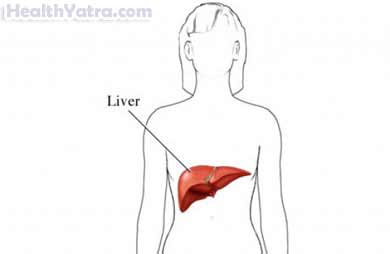Definition
Hemochromatosis is a condition in which the body builds up too much iron. Two types of hemochromatosis are:
Primary or Hereditary Hemochromatosis (HH)
This type is caused by inherited genes. These genes cause the stomach and intestines to absorb too much iron. It is the most common genetic disorder in the United States.
Secondary Hemochromatosis
This type results from treatments or diseases that cause iron to build up in the body. This may include:
- Dietary iron overload
- Juvenile hemochromatosis
- Anemias (eg, thalassemia)
- Chronic liver disease
If found early HH is easily treated. Untreated HH can lead to severe organ damage. Excess iron builds up in the cells of the liver, heart, pancreas, joints, and pituitary gland. This leads to diseases such as cirrhosis of the liver, liver cancer, diabetes,heart disease, and joint disease.

Causes
HH is caused by a genetic defect. It is passed down through autosomal recessive inheritance. This means a child who inherits two genes,one from each parent, is very likely to develop HH. However, not all people who have two copies of the gene develop signs and symptoms of HH.
Risk Factors
Factors that increase your chance for developing HH include:
- Family members with hemochromatosis
- Men: onset between 30-50 years old (hemochromatosis affects men five times more frequently than women)
- Women: 50 years old or older (postmenopausal)
- Western or Northern European ancestry
- Alcoholism (which can lead to liver disease and secondary hemochromatosis)
Symptoms
Many people have no symptoms when they are diagnosed. However, when they occur, symptoms may include:
- Joint pain (most common symptom)
- Fatigue, lack of energy
- Abdominal pain
- Loss of sex drive
- Heart problems
- Damage to the adrenal gland and resulting adrenal insufficiency
If the disease is not treated early, iron may build up in body tissues. This may eventually lead to serious problems such as:
- Arthritis
- Liver disease, including an enlarged liver, cirrhosis, cancer, and liver failure
- Damage to the pancreas, possibly causing diabetes
- Heart abnormalities, such as irregular heart rhythms or congestive heart failure
- Impotence
- Early menopause
- Abnormal pigmentation of the skin, making it look gray or bronze
- Thyroid deficiency
- Damage to the adrenal gland
Diagnosis
The doctor will ask about your symptoms. A medical history will be taken. A physical exam will be done.
Tests may include:
- Blood tests—determine whether the amount of iron stored in the body is too high
- Transferrin saturation test—determines how much iron is bound to the protein that carries iron in the blood
- Serum ferritin test—shows the level of iron in the liver
- Blood tests can determine if hemochromatosis is hereditary
- There are special blood tests to detect the mutation (C282Y and H63D mutations account for about 87% of HH cases)
- If the mutation is not present the doctor will look for other causes of iron build up
- Tests to examine the liver:
- Liver Biopsy —a tiny piece of liver tissue is removed. It is examined under a microscope. It will show how much iron has accumulated in the liver. It will also show any liver damage.
- Computed tomography (CT) scan of the abdomen —a type of x-ray. It uses a computer to make pictures of the inside of the body.
- Magnetic resonance imaging (MRI) scan of the abdomen—a test that uses magnetic waves to make pictures of the inside of the body .
- Ultrasound —a test that uses sound waves to examine the liver.
Treatment
Treatment is simple, inexpensive, and safe.
Blood Removal
The first step is to rid the body of excess iron. The process is called phlebotomy. This means removing blood. The schedule will depend on how severe the iron overload is. A pint of blood will be taken once or twice a week for several months to a year. It may last longer. Once iron levels return to normal, maintenance therapy is given. A pint of blood is given every 2 to 4 months for life. Some people may need it more often. Female patients may need to increase their schedule after menopause.
Lifestyle Changes
These include steps to reduce the amount of iron you consume and/or absorb, and to help protect your liver:
- Do not eat red meat or raw shellfish.
- Do not take vitamin C supplements.
- Do not take iron supplements.
- Avoid alcohol.
Treating Associated Medical Conditions
You may need to be treated for other conditions that have developed. Hemochromatosis can cause these to develop:
- Diabetes
- Liver cirrhosis
- Heart failure
Prevention
This condition is often undiagnosed and untreated. It is considered rare. Doctors may not think to test for it. The initial symptoms can be vague. They can also mimic many other diseases. Doctors may also focus on the conditions caused by HH rather than the underlying iron problem. If the iron overload is found and treated before organ damage, a person can live a normal, healthy life. Screening for hemochromatosis is not a routine part of medical care. Researchers and public health officials do have some suggestions:
- Brothers and sisters of people who have hemochromatosis should have their blood tested. This will help identify those that have the disease or are carriers.
- Parents, children, and other close relatives of people who have the disease should consider testing.
- Doctors should consider testing people who have joint disease, severe and continuing fatigue, heart disease, elevated liver enzymes, impotence, and diabetes. These conditions may result from hemochromatosis.
A genetic counselor can help you review your family history, determine your specific risks, and review the appropriate testing.
